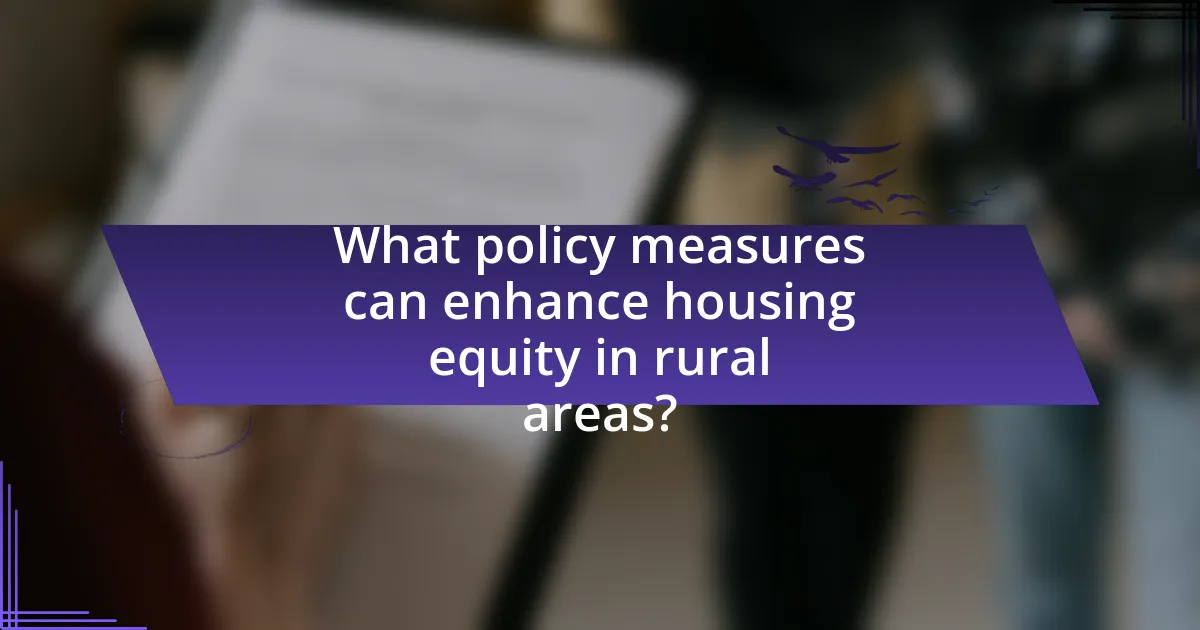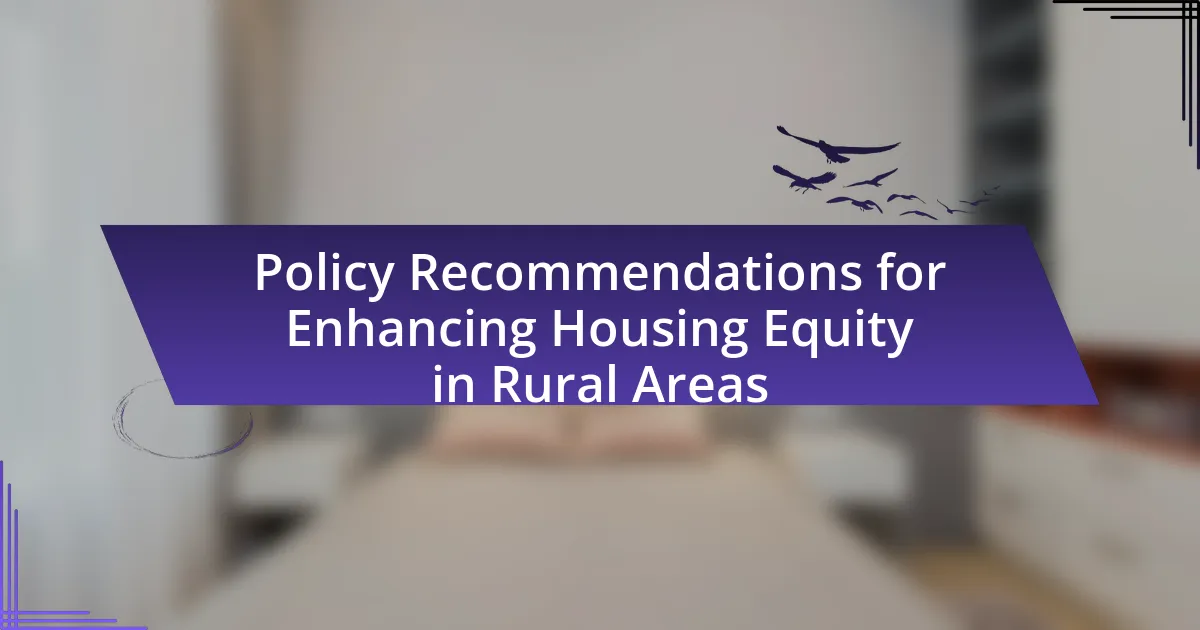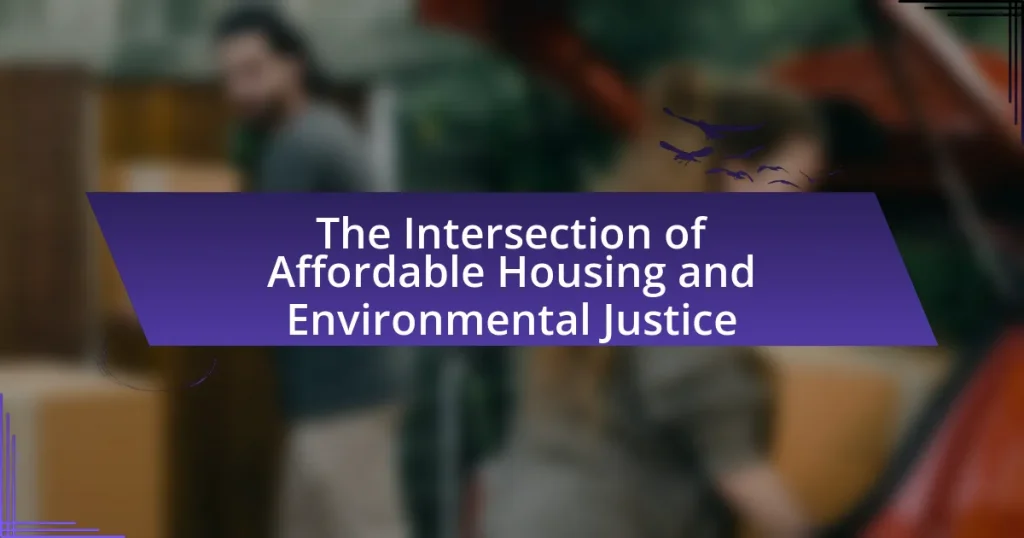The article focuses on policy recommendations for enhancing housing equity in rural areas, addressing key challenges such as limited access to affordable housing, inadequate infrastructure, and systemic discrimination. It explores the impact of socioeconomic factors, income inequality, and education levels on housing access, particularly for marginalized communities. The article also examines the role of zoning laws, government interventions, and community organizations in promoting housing equity, while highlighting effective strategies and case studies that demonstrate successful initiatives. Additionally, it discusses the importance of technology and data analytics in informing housing policy decisions and improving resource allocation.

What are the key challenges to housing equity in rural areas?
The key challenges to housing equity in rural areas include limited access to affordable housing, inadequate infrastructure, and systemic discrimination. Limited access to affordable housing is evident as rural areas often lack sufficient housing options that are both affordable and suitable for low-income families. Inadequate infrastructure, such as poor transportation and limited public services, exacerbates housing challenges by isolating residents from job opportunities and essential services. Systemic discrimination, including racial and economic biases, further hinders equitable access to housing, as marginalized groups may face barriers in securing housing due to discriminatory practices. These challenges collectively impede efforts to achieve housing equity in rural communities.
How do socioeconomic factors impact housing equity in rural regions?
Socioeconomic factors significantly impact housing equity in rural regions by influencing income levels, employment opportunities, and access to resources. In rural areas, lower income levels often correlate with limited access to affordable housing options, leading to disparities in housing quality and availability. For instance, according to the U.S. Department of Agriculture, rural households with lower incomes face higher housing cost burdens, which can exceed 30% of their income, limiting their ability to invest in better housing or maintain existing properties. Additionally, employment opportunities in rural regions are often concentrated in low-wage sectors, further exacerbating housing inequities. Access to education and healthcare also plays a crucial role; communities with limited educational resources tend to have lower socioeconomic mobility, perpetuating cycles of poverty and inadequate housing. Thus, socioeconomic factors create a complex web of challenges that hinder housing equity in rural areas.
What role does income inequality play in housing access?
Income inequality significantly restricts housing access by creating disparities in affordability and availability of quality housing. Individuals with lower incomes often face challenges in securing adequate housing due to rising property prices and rental costs, which outpace wage growth. For instance, a report from the National Low Income Housing Coalition indicates that in 2021, a worker earning minimum wage could afford only 1 in 4 rental homes in the U.S., highlighting the direct impact of income inequality on housing options. This economic divide leads to increased rates of homelessness and housing instability among low-income populations, further exacerbating social inequities.
How does education level affect housing opportunities?
Education level significantly affects housing opportunities by influencing income potential and employment stability. Individuals with higher education levels typically secure better-paying jobs, which enhances their ability to afford housing. For instance, data from the U.S. Bureau of Labor Statistics indicates that individuals with a bachelor’s degree earn approximately 67% more than those with only a high school diploma. This income disparity directly impacts housing options, as higher earners can access a wider range of housing markets and secure mortgages more easily. Additionally, higher education often correlates with increased financial literacy, enabling individuals to make informed decisions about homeownership and investments.
What barriers exist for marginalized communities in rural housing?
Marginalized communities in rural housing face several barriers, including limited access to financing, discriminatory lending practices, and inadequate infrastructure. Limited access to financing restricts these communities from obtaining loans or mortgages, often due to a lack of credit history or income verification. Discriminatory lending practices, such as redlining, further exacerbate the issue by denying loans based on race or ethnicity, which has been documented in studies showing that minority applicants are often denied loans at higher rates than their white counterparts. Additionally, inadequate infrastructure, including poor transportation and limited access to essential services, makes it difficult for marginalized groups to secure stable housing and maintain their residences. These barriers collectively hinder the ability of marginalized communities to achieve housing equity in rural areas.
How does discrimination influence housing availability?
Discrimination significantly reduces housing availability by creating barriers for marginalized groups in accessing housing opportunities. For instance, discriminatory practices such as redlining, where banks and insurers deny services based on race or ethnicity, limit the ability of these groups to secure mortgages or insurance, thereby restricting their housing options. According to a report by the National Fair Housing Alliance, communities of color are often subjected to higher rates of housing discrimination, which leads to a lack of affordable housing and increased homelessness among these populations. This systemic inequality not only affects individual access to housing but also perpetuates broader socio-economic disparities within communities.
What are the effects of zoning laws on housing equity?
Zoning laws significantly impact housing equity by regulating land use and determining the types of housing that can be built in specific areas. These regulations can create barriers to affordable housing development, often leading to increased housing costs and limited availability for low-income families. For instance, exclusionary zoning practices, which restrict the construction of multi-family units, can perpetuate socioeconomic segregation and limit access to quality housing for marginalized communities. Studies have shown that areas with restrictive zoning laws tend to have higher housing prices and lower rates of affordable housing availability, exacerbating disparities in housing equity.

What policy measures can enhance housing equity in rural areas?
Policy measures that can enhance housing equity in rural areas include implementing inclusionary zoning, increasing funding for affordable housing development, and providing financial assistance for low-income families. Inclusionary zoning mandates that a percentage of new housing developments be affordable for low-income residents, which can help diversify housing options. Increased funding for affordable housing can be achieved through federal and state programs, which have shown to improve access to housing for underserved populations. Additionally, financial assistance programs, such as down payment assistance or rental subsidies, can directly support low-income families in securing stable housing. These measures have been supported by studies indicating that targeted interventions can significantly reduce housing disparities in rural communities.
How can government interventions improve housing access?
Government interventions can improve housing access by implementing policies that increase affordable housing supply and provide financial assistance to low-income families. For instance, zoning reforms can facilitate the construction of more affordable units, while subsidies or tax credits can help lower-income households afford housing costs. According to the National Low Income Housing Coalition, there is a shortage of 7 million affordable rental homes for extremely low-income renters, highlighting the need for targeted government action to address this gap. Additionally, programs like the Housing Choice Voucher Program have been shown to increase housing stability and access for low-income families, demonstrating the effectiveness of government interventions in enhancing housing equity.
What types of subsidies are most effective for rural housing?
Direct cash assistance and low-interest loans are the most effective types of subsidies for rural housing. These financial aids directly address affordability issues by providing immediate financial relief to low-income families, enabling them to secure housing. For instance, programs like the USDA Rural Development’s Single Family Housing Direct Home Loans offer loans with interest rates as low as 1% for eligible applicants, significantly reducing the financial burden on rural households. Additionally, direct cash assistance programs, such as the Housing Choice Voucher Program, have been shown to improve housing stability and reduce homelessness in rural areas, as evidenced by studies indicating that such subsidies lead to increased housing quality and better living conditions for recipients.
How can land use policies be reformed to promote equity?
Land use policies can be reformed to promote equity by implementing inclusive zoning regulations that prioritize affordable housing development. Such regulations can ensure that a percentage of new housing units are designated as affordable, thereby increasing access for low-income families. For instance, cities like Minneapolis have adopted policies that eliminate single-family zoning, allowing for multi-family units and increasing housing diversity. This approach has been shown to reduce housing disparities and improve access to essential services for marginalized communities. Additionally, integrating community input into land use planning processes can help address the specific needs of underrepresented populations, ensuring that policies reflect the voices of those affected.
What role do community organizations play in housing equity?
Community organizations play a crucial role in advancing housing equity by advocating for policies that address systemic inequalities and providing resources to underserved populations. These organizations often engage in grassroots efforts to raise awareness about housing issues, mobilize community members, and influence local government decisions. For instance, studies have shown that community organizations can effectively increase access to affordable housing by facilitating partnerships between residents and policymakers, thereby ensuring that the voices of marginalized groups are heard in the decision-making process. Additionally, they often provide direct support services, such as legal assistance and financial education, which empower individuals to navigate the housing market more effectively.
How can local initiatives support affordable housing development?
Local initiatives can support affordable housing development by fostering community engagement and collaboration among stakeholders. These initiatives often involve local governments, non-profit organizations, and community members working together to identify housing needs and develop tailored solutions. For instance, programs like community land trusts have successfully increased affordable housing stock by allowing communities to collectively own land and manage its development, as evidenced by the success of the Burlington Community Land Trust in Vermont, which has created over 300 affordable homes since its inception. Additionally, local initiatives can leverage funding from state and federal sources, as seen in the Low-Income Housing Tax Credit program, which incentivizes private investment in affordable housing projects.
What partnerships are essential for successful housing programs?
Successful housing programs require partnerships between government agencies, non-profit organizations, and private sector developers. Government agencies provide regulatory frameworks and funding, non-profit organizations offer community insights and support services, while private sector developers bring expertise in construction and financing. For instance, the U.S. Department of Housing and Urban Development collaborates with local governments and non-profits to implement programs like the Community Development Block Grant, which has funded over $150 billion in community development since its inception. This multi-faceted collaboration ensures that housing programs are effectively tailored to meet the needs of diverse populations, particularly in rural areas where resources may be limited.

What best practices can be implemented for sustainable housing equity?
Best practices for sustainable housing equity include implementing inclusive zoning policies, promoting affordable housing development, and ensuring access to essential services. Inclusive zoning policies allow for diverse housing types, which can accommodate various income levels and family sizes, thereby fostering community integration. Promoting affordable housing development through incentives for builders can increase the availability of low-cost housing options, addressing the demand-supply gap. Ensuring access to essential services, such as transportation, healthcare, and education, is crucial for enhancing the livability of housing areas, particularly in rural settings where resources may be limited. These practices are supported by studies indicating that equitable access to housing and services leads to improved community outcomes and economic stability.
How can technology be leveraged to improve housing equity?
Technology can be leveraged to improve housing equity by utilizing data analytics, digital platforms, and innovative financing solutions. Data analytics can identify housing disparities and inform policy decisions, enabling targeted interventions in underserved communities. Digital platforms facilitate access to housing resources, allowing marginalized groups to connect with affordable housing options and services. Additionally, innovative financing solutions, such as crowdfunding and blockchain technology, can provide alternative funding sources for low-income housing projects, thereby increasing the availability of affordable housing. For instance, a report by the Urban Institute highlights how data-driven approaches can enhance housing policy effectiveness and promote equitable outcomes.
What digital tools can assist in housing resource allocation?
Digital tools that can assist in housing resource allocation include Geographic Information Systems (GIS), data analytics platforms, and online housing management software. GIS enables the visualization of spatial data, helping policymakers identify areas of need and allocate resources effectively. Data analytics platforms, such as Tableau or Microsoft Power BI, allow for the analysis of demographic and housing data, facilitating informed decision-making. Online housing management software, like Yardi or AppFolio, streamlines the allocation process by managing tenant information and tracking resource distribution. These tools enhance efficiency and accuracy in addressing housing equity challenges in rural areas.
How can data analytics inform housing policy decisions?
Data analytics can inform housing policy decisions by providing evidence-based insights into housing trends, demographics, and needs. By analyzing data such as income levels, housing prices, and population growth, policymakers can identify areas of housing inequity and prioritize resources effectively. For instance, a study by the Urban Institute found that data-driven approaches can lead to more targeted interventions, improving access to affordable housing in underserved communities. This analytical framework enables policymakers to make informed decisions that address specific housing challenges, ultimately enhancing housing equity in rural areas.
What are the lessons learned from successful rural housing initiatives?
Successful rural housing initiatives demonstrate the importance of community involvement and tailored solutions. Engaging local residents in the planning and implementation processes ensures that housing projects meet the specific needs of the community, leading to higher satisfaction and sustainability. For instance, the Rural Housing Service in the United States has shown that programs which incorporate local input result in more effective use of resources and better alignment with community priorities. Additionally, successful initiatives often leverage partnerships with non-profits and government agencies to pool resources and expertise, enhancing the overall impact. Evidence from the National Low Income Housing Coalition indicates that collaborative approaches can significantly improve housing outcomes in rural areas, as they address both housing supply and affordability challenges.
Which case studies exemplify effective housing equity strategies?
Case studies that exemplify effective housing equity strategies include the “Community Land Trusts” model in Burlington, Vermont, and the “Equitable Development Initiative” in Portland, Oregon. The Burlington Community Land Trust has successfully provided affordable housing options by separating land ownership from housing ownership, ensuring long-term affordability and community control. In Portland, the Equitable Development Initiative focuses on supporting marginalized communities through investments in affordable housing and community resources, demonstrating a commitment to equitable development. Both case studies illustrate how targeted strategies can enhance housing equity in rural areas by addressing systemic barriers and promoting sustainable community development.
How can these lessons be adapted to different rural contexts?
Lessons on enhancing housing equity can be adapted to different rural contexts by tailoring strategies to local demographics, economic conditions, and cultural values. For instance, in economically disadvantaged rural areas, policies may focus on affordable housing development and financial assistance programs, while in regions with a strong agricultural base, initiatives could emphasize sustainable housing practices that align with farming needs. Evidence from the Rural Housing Service indicates that localized approaches, such as community engagement and stakeholder collaboration, significantly improve the effectiveness of housing policies, ensuring they meet the unique needs of each rural community.
What practical steps can communities take to enhance housing equity?
Communities can enhance housing equity by implementing inclusive zoning policies that promote affordable housing development. These policies can include measures such as increasing density allowances, reducing minimum lot sizes, and providing incentives for developers to include affordable units in their projects. For instance, cities like Minneapolis have adopted such policies, resulting in a more diverse housing stock and improved access for low-income families. Additionally, communities can establish land trusts to acquire and preserve affordable housing, ensuring long-term affordability and stability for residents. Research indicates that community land trusts can effectively mitigate displacement and promote equitable access to housing, as evidenced by successful models in cities like Burlington, Vermont.



